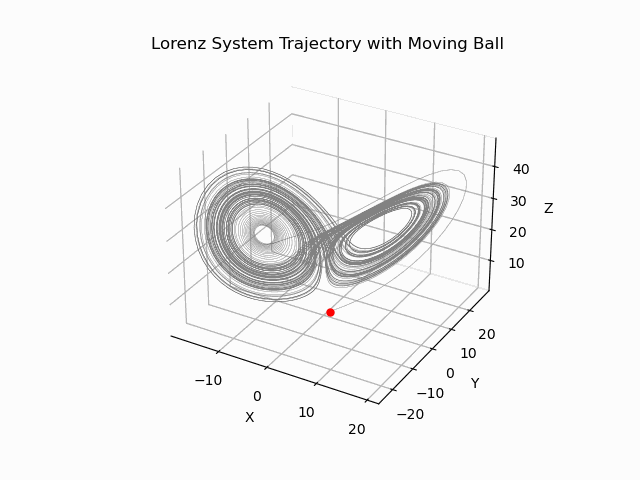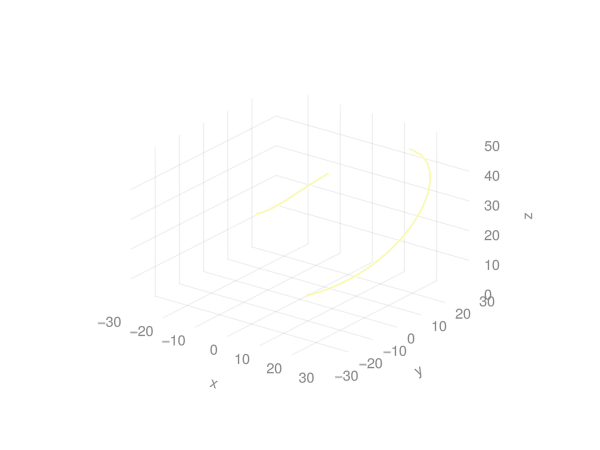problem06
Author
Vishal Paudel
Published
January 24, 2025
6. Spring and mass (2D).
One end of of a negligible-mass spring (k, L0) is pinned to the origin, the other to a mass (m). There is gravity (g). Initial Conditions (ICs): The initial position is \(\vec{r}_0 = x_0\hat{i} + y_0\hat{j}\), and the initial velocity is \(\vec{v}_0 = v_{x0}\hat{i} + v_{y0}\hat{j}\). Motion starts at \(t = 0\) and ends at tend.
- Find the Equations of Motion (EoM);
- Assume all parameters and IC’s above are given.
- Plot the trajectory of the mass.
- Animate the trajectory of the mass.
- Plot the trajectory of the mass.
- How many ways can you think of checking the numerical solution, find as manyas you can, and do the check. The list is started here:
- k = 0, all else arbitrary: The motion is parabolic flight (including fallingstraight down as a special case) [Why? The system is then just ballisticsfrom freshman physics];
- x0 = 0, vx0 = 0, all else arbitrary: The motion stays on the y axis [Why?There is no force in the x direction if the mass is on the y axis. Becausethe initial velocity has no x component, the mass never leaves the y axis;
- g = 0,v0 =0, all else is arbitrary: The motion stays on a radial line. And,if the motion does not cross the origin, the motion is that of a harmonicoscillator (sinusoidal oscillations, check by plotting, say x vt t. [Why? Writethe EoM and EoMs in polar coordinates⇒ mr¨ = −k(r − L0) ⇒ the harmonic oscillator equation, mr¨∗ =−kr∗, where r∗ ≡ r − L0.
- L0 = 0, all else is arbitrary: ? . [Why? ? .] Hint, this onespecial case is problem 10, below.v. etc.vi. etc.vii. . . .
1 Instead, simulating lorentz system
Since I already did all of this pretty much in problem01. I will instead write a simple lorentz system and animate it here.
using DifferentialEquations
using GLMakie
# ----------------------------
# Define the Lorenz System
# ----------------------------
# The Lorenz system is given by:
# dx/dt = σ (y - x)
# dy/dt = x (ρ - z) - y
# dz/dt = x y - β z
function lorenz!(du, u, p, t)
σ, ρ, β = p
du[1] = σ * (u[2] - u[1])
du[2] = u[1] * (ρ - u[3]) - u[2]
du[3] = u[1] * u[2] - β * u[3]
end
# ----------------------------
# Set Parameters, Initial Conditions, and Solve the ODE
# ----------------------------
# Typical parameter values for the Lorenz system:
p = (10.0, 28.0, 8/3)
u0 = [1.0, 0.0, 0.0] # initial condition
tspan = (0.0, 40.0) # simulation time
# Set up the ODE problem and solve it.
prob = ODEProblem(lorenz!, u0, tspan, p)
sol = solve(prob, Tsit5(); saveat=0.01)
# ----------------------------
# Create the Animation with Makie
# ----------------------------
# Create a new scene with a 3D camera.
scene = Scene(resolution = (800, 600), camera = campixel!)
# Plot the full trajectory as a blue line.
lines!(scene, sol[1, :], sol[2, :], sol[3, :],
color = :blue, linewidth = 1)
# Initialize a red marker for the moving point.
# We start with the first position.
point = scatter!(scene, [sol[1,1]], [sol[2,1]], [sol[3,1]],
markersize = 15, color = :red)
# Record the animation. Here, each frame updates the position of the point.
record(scene, "lorenz_animation.gif", length(sol.t)) do i
# Update the marker position to the i-th solution point.
point[1].attributes[:positions][] = Point3f0(sol[1,i], sol[2,i], sol[3,i])
# Optionally, you can adjust the frame rate by pausing briefly:
sleep(0.001)
end
println("Animation saved as lorenz_animation.gif")This produces the following animation:

../../media/problem06/lorentz_attractor.gif
The code given on
Makie.jl library website:
using GLMakie
Base.@kwdef mutable struct Lorenz
dt::Float64 = 0.01
σ::Float64 = 10
ρ::Float64 = 28
β::Float64 = 8/3
x::Float64 = 1
y::Float64 = 1
z::Float64 = 1
end
function step!(l::Lorenz)
dx = l.σ * (l.y - l.x)
dy = l.x * (l.ρ - l.z) - l.y
dz = l.x * l.y - l.β * l.z
l.x += l.dt * dx
l.y += l.dt * dy
l.z += l.dt * dz
Point3f(l.x, l.y, l.z)
end
attractor = Lorenz()
points = Observable(Point3f[])
colors = Observable(Int[])
set_theme!(theme_light())
fig, ax, l = lines(points, color = colors,
colormap = :inferno, transparency = true,
axis = (; type = Axis3, protrusions = (0, 0, 0, 0),
viewmode = :fit, limits = (-30, 30, -30, 30, 0, 50)))
record(fig, "lorenz_makie.gif", 1:120) do frame
for i in 1:50
push!(points[], step!(attractor))
push!(colors[], frame)
end
ax.azimuth[] = 1.7pi + 0.3 * sin(2pi * frame / 120)
notify(points)
notify(colors)
l.colorrange = (0, frame)
endThis produces:

../../media/problem06/lorenz_makie.gifIs there a way to think about verifying (insanity-checking) lorentz system solutions? I haven’t thought through this yet.